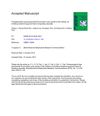Live Imaging of Smad2/3 Signaling in Mouse Skin Wound Healing
September 2007
in “
Wound repair and regeneration
”

TLDR Smad2/3-dependent TGF-β signaling increases during wound healing.
The study utilized biophotonics and real-time imaging in transgenic mice to observe Smad2/3 signaling during skin wound healing. Two types of wounds were created: one sutured and one healing by secondary intention, with 8 samples each. Bioluminescence, indicating TGF-β signaling, increased post-wounding, peaking on day 17 at four times the baseline level (p < 0.05). Sutured wounds showed earlier peak activity compared to secondary healing wounds, though not statistically significant. Phospho-Smad2/3 was intensely stained in hair follicles. The study concluded that Smad2/3-dependent TGF-β signaling increased during wound healing, differing from other studies that reported elevated signaling immediately after wounding.


